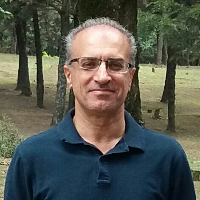Temperature and Light Effects on Volunteer's Rapeseed (Brassica napus L.) Secondary Dormancy and Germination
Author(s):
Article Type:
Research/Original Article (دارای رتبه معتبر)
Abstract:
Introduction
Rapeseeds are susceptible to shuttering during harvest increasing soil seed bank. Secondary dormancy is induced in shuttered seeds due to dryness and darkness conditions of soil in summer season and its level is different based on the seed types. Germination may be observed in seeds with low level of secondary dormancy. Before initiation of the next growing season and under undesirable environmental conditions seedlings will die. In contrast, high level of secondary dormancy in the other seeds is not eliminated and then they will emerge in the next growing season along with the crops as rapeseed volunteers. Rapeseed volunteers are considered as weeds in the next growing season and transfer target genes from crops to relative plants and weeds during pollination causing a decrease in quality, yield, and eventually purity of produced seeds.Materials And Methods
Six rapeseeds cultivars and lines were selected with different secondary dormancy levels of low (Gor-o-16 and Gor-H-4), medium (Zarfam and RGS003), and high (Gor-o-4 and Gor-o-6) among 46 lines and/or cultivars of the previous study. Three replications of different seeds were placed in incubator at 20°C in darkness before induction of secondary dormancy (primarily secondary dormancy was determined). In fact, three replications of seeds with different levels of secondary dormancy were first exposed to inducing condition of secondary dormancy (-15 bar potential for 14 days) and then exposed to different treatments of temperature and light i.e. 20°C (darkness), 20°C (light), 25°C (darkness), 25°C (light), 30°C (darkness), 30°C (light), 3-30°C (darkness,12/12hours), 3-30°C (darkness/light (12/12 hours)), 20-30°C (darkness, 12/12 hours) and 20-30°C (darkness/light (12/12 hours)). Finally, secondary dormancy responses were analyzed.Result and
Discussion
Average primary germination in all seeds including cultivars and lines of rapeseeds before secondary dormancy induction was higher than 98% implying the absence of primary dormancy. After secondary dormancy induction, the highest germination was shown in the seeds with low level of seeds secondary dormancy at constant temperature in darkness and light. It was decreased in those with medium level of secondary dormancy by increasing temperature from 20 to 30°C in darkness, even though decreasing process was higher in light treatment. But it was the same in the seeds with secondary dormancy in comparison with medium levels of secondary dormancy in darkness and light. High level of secondary dormancy in G-O-6 and G-O-4 can be attributed to their responses to increased temperature and the light, respectively. Secondary dormancy was eliminated in seeds with high level of secondary dormancy by being exposed to 3-30°C treatment in darkness that implied replacement of alternative temperature with light requirement. Secondary dormancy was not completely eliminated for 20-30°C and 30°C treatments as some parts of seed population need alternative temperature and the others require light for complete elimination. Some studies suggested that light is required for complete elimination of secondary dormancy as it influences hormonal balance indirectly through phytochromic pathways. Moreover, the other studies reported that secondary dormancy can be partially eliminated by impacting heat shock proteins and light requirement. Rapeseeds appear to be photoblastic after inducing secondary dormancy. Further studies are required on the roles of phytochromes and hormonal balance pathways of ABA and GA in eliminating secondary dormancy of rapeseeds.Conclusion
Different rapeseed responses with different levels of secondary dormancy after being placed in soil seed bank were simulated by laboratory conditions with emphasis on two environmental factors of temperature and light. The same response was shown by increasing constant temperature in rapeseed with different levels of secondary dormancy. Decrease in secondary dormancy was obvious in them and a greater increase was found for mentioned treatment in light. Secondary dormancy in all seeds was entirely eliminated after being exposed to alternative temperature and light. Complete elimination of secondary dormancy was observed in response to 3-30°C alternative temperature whether in darkness or darkness/light conditions. It was found that light requirement can be removed after induction of secondary dormancy by 3-30°C alternative temperature in darkness. However, secondary dormancy was only eliminated in some parts of seed population by 20-30°C and 30°C. In addition, light was observed as a critical factor for breaking for the others. It can be thus concluded that light was required for eliminating secondary dormancy in rapeseeds and seeds became photoblastic after the induction. Therefore, secondary dormancy can be removed before next growing season by being exposed to mentioned temperature and light.Keywords:
Language:
Persian
Published:
Journal of plant protection, Volume:32 Issue: 2, 2018
Pages:
269 to 278
magiran.com/p1864941
دانلود و مطالعه متن این مقاله با یکی از روشهای زیر امکان پذیر است:
اشتراک شخصی
با عضویت و پرداخت آنلاین حق اشتراک یکساله به مبلغ 1,390,000ريال میتوانید 70 عنوان مطلب دانلود کنید!
اشتراک سازمانی
به کتابخانه دانشگاه یا محل کار خود پیشنهاد کنید تا اشتراک سازمانی این پایگاه را برای دسترسی نامحدود همه کاربران به متن مطالب تهیه نمایند!
توجه!
- حق عضویت دریافتی صرف حمایت از نشریات عضو و نگهداری، تکمیل و توسعه مگیران میشود.
- پرداخت حق اشتراک و دانلود مقالات اجازه بازنشر آن در سایر رسانههای چاپی و دیجیتال را به کاربر نمیدهد.
دسترسی سراسری کاربران دانشگاه پیام نور!
اعضای هیئت علمی و دانشجویان دانشگاه پیام نور در سراسر کشور، در صورت ثبت نام با ایمیل دانشگاهی، تا پایان فروردین ماه 1403 به مقالات سایت دسترسی خواهند داشت!
In order to view content subscription is required
Personal subscription
Subscribe magiran.com for 70 € euros via PayPal and download 70 articles during a year.
Organization subscription
Please contact us to subscribe your university or library for unlimited access!



